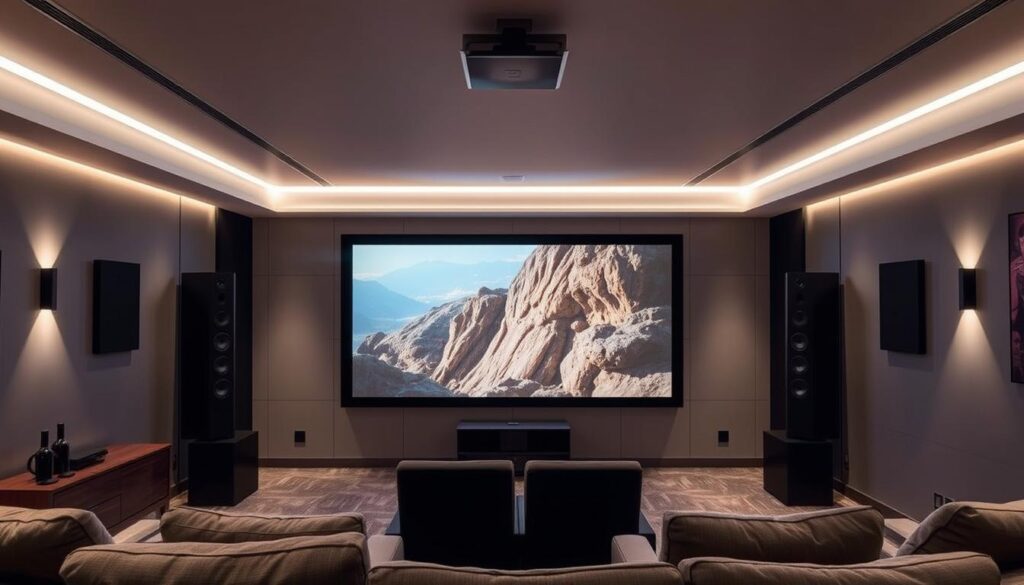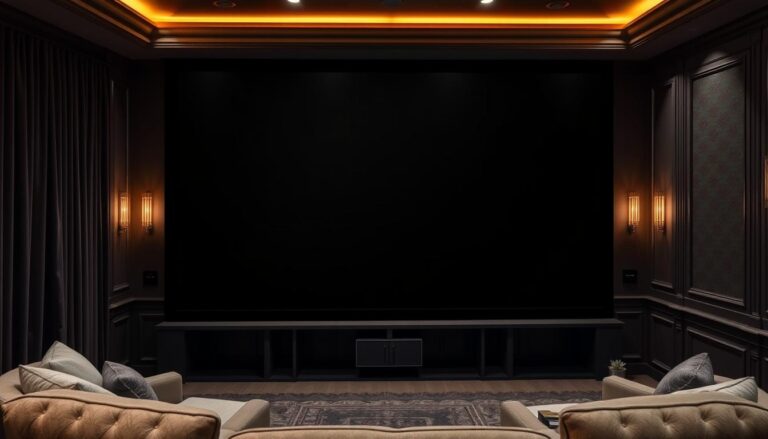Setting up a home theater with top-notch screens can really improve your viewing experience. Home theater screens made from cinema screen fabric are key. When picking the right cinema screen fabric, think about the fabric type and its features. High-quality screens can greatly enhance your viewing experience.
It’s important to understand cinema screen fabric basics to make a good choice. Cinema screen fabric is made to give you an immersive viewing experience. Home theater screens vary, and picking the right one can be tough. This guide will help you choose the perfect cinema screen fabric for your home theater. You’ll get the best viewing experience with your high-quality screens.
Understanding Cinema Screen Fabric Types
Choosing the right screen fabric is key for a great home theater. There are many screen fabric types to pick from. Acoustic transparent screens are popular because they let speakers sound good even when hidden behind the screen.
On the other hand, non-acoustic screens are cheaper but might not sound as good. If your room isn’t dark, ambient light rejecting fabrics are a smart pick. They help keep the screen clear of light, making your movie nights better.

- Sound quality: If you plan to place speakers behind the screen, consider acoustic transparent screens.
- Light control: For rooms with ambient light, ambient light rejecting fabrics can help improve the viewing experience.
- Budget: Non-acoustic screen fabrics are a more affordable option, but may compromise on sound quality.
Knowing about the different screen fabrics helps you pick the best one. This way, you can set up a home theater that’s just right for you and offers a top-notch viewing experience.
| Screen Fabric Type | Sound Quality | Light Control | Budget |
|---|---|---|---|
| Acoustic Transparent | High | Medium | High |
| Non-Acoustic | Low | Low | Low |
| Ambient Light Rejecting | Medium | High | Medium |
Essential Features of Premium Cinema Screen Fabric
Creating an immersive home theater setup starts with the screen material. A premium screen fabric can make your viewing experience better. Look for high gain, wide viewing angles, and durable materials.
In a home theater, the screen material is key. High-quality screen fabrics can greatly improve your viewing experience. Think about your room size, lighting, and projector type when choosing a fabric. For example, a high gain screen can brighten images in low light, and wide angles ensure everyone sees well.
Some popular features of premium screen fabrics include:
- High gain for brighter images
- Wide viewing angles for better visibility
- Durable materials for long-lasting performance
- Acoustic transparency for clear sound
Choosing a premium screen fabric with these features can enhance your home theater. Whether watching a movie or playing a game, a quality screen makes a big difference. It brings brighter images, clearer sound, and a more immersive experience.
| Feature | Description |
|---|---|
| High Gain | Provides brighter images for a more immersive experience |
| Wide Viewing Angle | Ensures everyone in the room has a great view |
| Durable Materials | Withstands the test of time for long-lasting performance |
Choosing the Right Screen Gain and Texture
Creating an immersive home theater experience depends on screen gain and texture. Screen gain shows how well a screen reflects light. Texture affects image sharpness and clarity. A wide viewing angle ensures the image stays clear, no matter where you sit.
Screen gain values are key when picking a screen for your projector. High gain screens work best with bright projectors. And low gain screens are better for dim projectors. It’s also important to consider how texture impacts image quality, as different textures work better with different projectors.
Understanding Screen Gain Values
Screen gain values range from 0.8 to 2.5, with 1.0 being the standard. A gain of 1.0 offers neutral color balance, perfect for most theaters. But, higher gains can make images brighter, though they might lose some color accuracy.
Texture Impact on Image Quality
The screen’s texture greatly affects image quality. Smooth textures make images sharper, while textured ones can soften them. Some screens have special textures to reduce texture impact and improve clarity.
Viewing Angle Considerations
A wide viewing angle is crucial for home theaters. It lets everyone watch from different spots without losing image quality. Screens with wide angles offer clear images, even from the sides.
In conclusion, picking the right screen gain and texture is vital for a great home theater. Knowing about screen gain values, texture impact, and viewing angles helps you choose a screen. This ensures a clear, vibrant, and engaging image, no matter the projector or viewing spot.
| Screen Gain Value | Texture Type | Viewing Angle |
|---|---|---|
| 1.0 | Smooth | 30 degrees |
| 1.5 | Textured | 45 degrees |
| 2.0 | Specialized | 60 degrees |
Installation and Mounting Considerations – cinema screen fabric
Setting up your home theater right is key for a great viewing experience. You need to plan and execute well to make sure your screen is securely attached to the wall and level. The type of wall and mounting options you have will affect how you set up your home theater setup.
Here are some things to think about for a smooth installation:
- Wall type: You need the right hardware for your wall type to ensure a stable installation.
- Mounting hardware: Pick the right stuff to hold the weight and size of your screen.
- Screen level: Make sure the screen is perfectly level to avoid image distortion.
A good screen installation will make your viewing better and protect your investment. By picking the right mounting options and installing your screen right, you’ll get a great visual experience at home. Your home theater setup will be perfectly optimized.
| Screen Size | Mounting Option | Wall Type |
|---|---|---|
| Small (up to 100″) | Fixed mount | Drywall or wood |
| Medium (100″-150″) | Tilt mount | Concrete or brick |
| Large (over 150″) | Motorized mount | Any type |
Maintaining Your Cinema Screen Fabric
Keeping your cinema screen fabric in good shape is key. It helps your screen last longer and look great. Cleaning it regularly stops dust and dirt from ruining the picture.
Cleaning Best Practices
To clean your screen, use a soft, dry cloth. Gently wipe away dust or dirt. Don’t use harsh chemicals or rough materials that can harm the fabric.
If you need a deeper clean, mix a little mild soap with water. Make sure to rinse your cloth well. Don’t soak the fabric.
Environmental Protection Tips On cinema screen fabric
Things like humidity, temperature, and sunlight can hurt your screen. To keep it safe, install it in a room with steady temperature and humidity. Also, don’t put it where sunlight hits it straight on.
- Avoid extreme temperatures
- Keep the screen away from direct sunlight
- Maintain a stable humidity level
By following these tips, you can make your screen last longer. It will keep giving you a top-notch viewing experience.
| Screen Maintenance Tips | Environmental Protection Tips |
|---|---|
| Regular cleaning | Avoid extreme temperatures |
| Use a soft, dry cloth | Keep the screen away from direct sunlight |
| Avoid harsh chemicals | Maintain a stable humidity level |
Conclusion: Making the Right Choice for Your Home Theater
Choosing the right cinema screen fabric is key for a great home theater. There are many options, like materials that block light and others that let sound pass through. These choices can make your home theater feel like a real cinema.
Think about the screen’s fabric, like its gain and texture. These affect how clear the picture is and how immersed you feel. Also, keeping your screen clean and protected helps it last longer and work better.
Getting the right screen fabric can turn your home into a top-notch entertainment spot. You and your family can watch movies and shows with amazing clarity. Making a smart choice means you’ll enjoy a viewing experience that’s both captivating and immersive, right in your own home.
FAQ’s About cinema screen fabric
What are the different types of cinema screen fabrics?
There are several types of cinema screen fabrics. Acoustic transparent screens let speakers be placed behind the screen without losing sound quality. Non-acoustic fabrics are cheaper but might not sound as good. Ambient light rejecting fabrics help reduce light impact, making viewing better in less dark rooms.
What are the essential features of premium cinema screen fabric?
Premium cinema screen fabrics have key features. They offer high gain for brighter images and wide viewing angles for better visibility. They are also durable, lasting a long time. When picking a premium screen, think about your room size, lighting, and projector type.
How do I choose the right screen gain and texture for my home theater?
Choosing the right screen gain and texture is key for great image quality. Screen gain affects brightness, and texture impacts sharpness and clarity. Consider your projector type and the room’s viewing angles for the best image.
What are the key considerations for installing and mounting my cinema screen fabric?
Installing and mounting your screen correctly is vital for a great viewing experience. Think about the wall type, choose the right hardware, and make sure the screen is level and secure. Careful installation avoids damage to the screen.
How can I maintain and protect my cinema screen fabric?
Keeping your screen fabric in good condition is important. Clean it gently with the right materials to avoid damage. Environmental factors like humidity and sunlight can also affect it. Proper cleaning and protection help maintain your screen’s quality.


